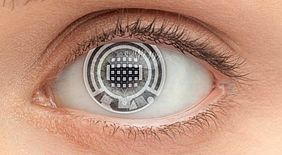In Italian there is a saying: "the eyes are the mirror of the soul". And it is not just in Italian.
“The eyes are the mirror of the soul and reflect everything that seems to be hidden; and like a mirror, they also reflect the person looking into them.” (quote Paulo Coelho, Manuscript found in Accra).
Literature aside, our eyes can indeed reveal quite a bit about our health. The retinal blood vessels provide tell tale signs of a variety of diseases. Tears carry with them molecules that mirror the ones in the blood, like glucose.
Researchers at the Oregon State University have worked on creating contact lenses with sensors that can detect the presence of glucose in the tears. The problem, of course is that these sensors have to be transparent to light. It turns out that the material used in displays, indium gallium zinc oxide (IGZO), that is transparent, can also be used to create sensors. The sensor is made by placing an enzyme, glucose oxidase, in contact with a field effect transistor made with IGZO. When glucose enters in contact with the enzyme the ph of the solution changes and this affect the conductivity of the transistor providing a sign of the presence of glucose. Note that the concentration of glucose in tears is way lower than the one in blood, so the sensors in the contact lenses need to be much more sensitive than the ones used to detect glucose in blood.
The sensor developed indeed has been proven to work nicely. Interestingly, the way the sensor is made opens the door to sensing many other types of molecule, one needs to couple the transistor with the appropriate enzyme. The team has already experimented with different types of sensors, like one placed on a catheter to detect uric acid.
According to the researchers it would be possible to include 2,000 different sensors in a patch of just one square mm on a contact lens, transforming it into a full lab on our eyes! However, it will take over one year to have a safe contact lenses prototype that can be tested on animals, and several more before we car wear those contact lenses.







